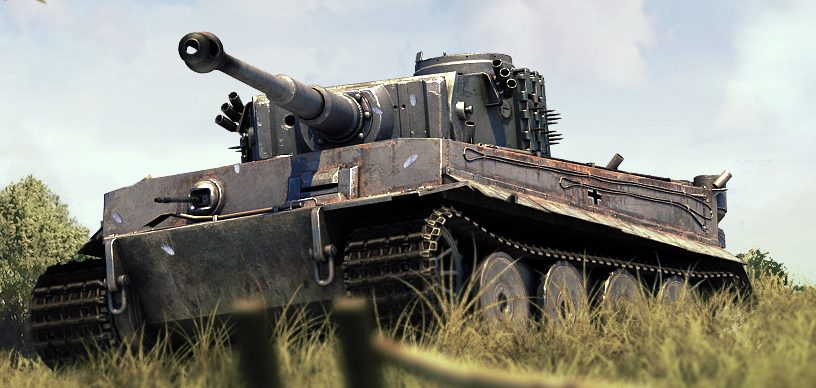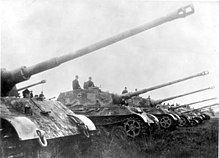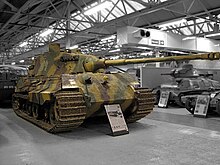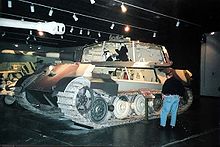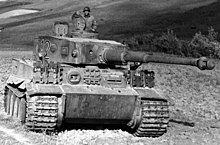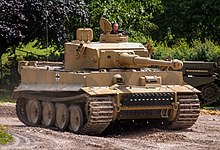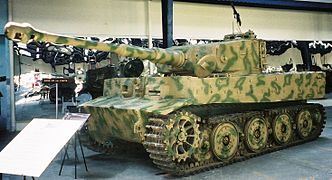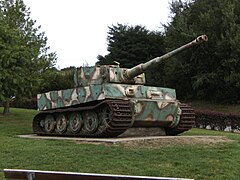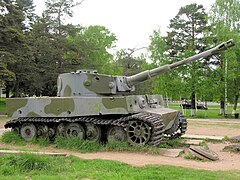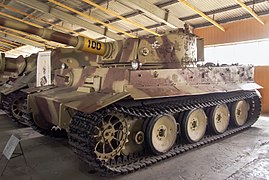Panther tank
| Panzerkampfwagen V Panther | |
|---|---|
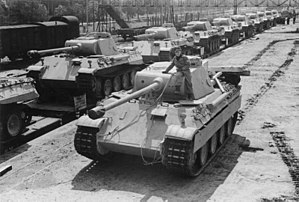
Panther Ausf. D tanks, 1943. The D model can best be recognized by the drum-shaped cupola.
|
|
| Type | Medium tank |
| Place of origin | Nazi Germany |
| Service history | |
| In service |
|
| Used by | Nazi Germany France Limited use by other militaries (see Postwar and foreign use) |
| Wars | World War II |
| Production history | |
| Designer | MAN AG |
| Designed | 1942 |
| Manufacturer | MAN, Daimler-Benz, MNH |
| Unit cost | 117,100 Reichmarks (Without weapons, optics, or radio) 176,100 Reichmarks (combat ready)[1] |
| Produced | 1943–1945 (1946- 9 postwar for the British Army) |
| No. built | about 6,000[2] |
| Variants | Ausf. D, Ausf. A, Ausf. G, Befehlspanzer (command tank), Beobachtungspanzer (artillery observer vehicle), Bergepanther (armoured recovery vehicle) |
| Specifications | |
| Weight | 44.8 tonnes (44.1 long tons; 49.4 short tons)[3] |
| Length | 6.87 m (22 ft 6 in) 8.66 metres (28 ft 5 in) gun forward[3] |
| Width | 3.27 m (10 ft 9 in)[3] 3.42 m (11 ft 3 in) with skirts |
| Height | 2.99 m (9 ft 10 in) |
| Crew | 5 (driver, radio-operator/hull machine gunner, commander, gunner, loader) |
|
|
|
| Armour | up to 100 mm |
|
Main
armament |
|
|
Secondary
armament |
|
| Engine | V-12 petrol Maybach HL230 P30[3] 700 PS (690 hp, 515 kW) |
| Power/weight | 15.39 PS (11.5 kW)/tonne (13.77 hp/ton) |
| Transmission | ZF AK 7-200. 7 forward 1 reverse[3] |
| Suspension | double torsion bar, interleaved road wheels |
| Fuel capacity | 720 litres (160 imp gal; 190 US gal) |
|
Operational
range |
Road: 200 km (120 mi) Cross-country: 100 km (62 mi) [4] |
| Speed | 55 km/h (34 mph) (first models) 46 km/h (29 mph) (later models) |
The Panther is a German medium tank deployed during World War II on the Eastern and Western Fronts in Europe from mid-1943 to the war’s end in 1945. It had the ordnance inventory designation of Sd.Kfz. 171. It was designated as the Panzerkampfwagen V Panther until 27 February 1944, when Hitler ordered that the Roman numeral “V” be deleted. Contemporary English language reports sometimes refer to it as the Mark V.
The Panther was intended to counter the Soviet T-34 and to replace the Panzer III and Panzer IV. Nevertheless, it served alongside the Panzer IV and the heavier Tiger I until the end of the war. It is considered one of the best tanks of World War II for its excellent firepower and protection, although its reliability was less impressive.[5]
The Panther was a compromise. While having essentially the same engine as the Tiger I, it had more efficient frontal hull armour,[6] better gun penetration, was lighter and faster, and could traverse rough terrain better than the Tiger I. The trade-off was weaker side armour, which made it vulnerable to flanking fire. The Panther proved to be effective in open country and long range engagements, but did not provide enough high explosive firepower against infantry.[7]
The Panther was far cheaper to produce than the Tiger I, and only slightly more expensive than the Panzer IV. Key elements of the Panther design, such as its armour, transmission, and final drive, were simplifications made to improve production rates and address raw material shortages. The overall design remained somewhat over-engineered.[8][9] The Panther was rushed into combat at the Battle of Kursk despite numerous unresolved technical problems, leading to high losses due to mechanical failure. Most design flaws were rectified by late 1943 and the spring of 1944, though the bombing of production plants, increasing shortages of high quality alloys for critical components, shortage of fuel and training space, and the declining quality of crews all impacted the tank’s effectiveness.
Though officially classified as a medium tank, its weight is more like that of a heavy tank, as its weight of 44.8 tons puts it roughly in the same category as the American M26 Pershing (41.7 tons), British Churchill (40.7 tons) and the Soviet IS-2 (46 tons) heavy tanks. The tank had a very high power to weight ratio however, making it extremely mobile regardless of its tonnage. Its weight still caused logistical problems however, such as an inability to cross certain bridges.
Development and production
Design
Albert Speer examines a T-34 in June 1943
The Panther was born out of a project started in 1938 to replace the Panzer III and Panzer IV tanks. The initial requirements of the VK 20 series called for a fully tracked vehicle weighing 20 tonnes and design proposals by Krupp, Daimler Benz and MAN ensued. These designs were abandoned and Krupp dropped out of the competition entirely as the requirements increased to a vehicle weighing 30 tonnes, a direct reaction to the encounters with the Soviet T-34 and KV-1 tanks and against the advice of Wa Pruef 6.[Notes 1][10] The T-34 outclassed the existing models of the Panzer III and IV.[11][12] At the insistence of General Heinz Guderian, a special tank commission was created to assess the T-34.[13] Among the features of the Soviet tank considered most significant were the sloping armour, which gave much improved shot deflection and also increased the effective armour thickness against penetration, the wide track, which improved mobility over soft ground, and the 76.2 mm (3.00 in) gun, which had good armour penetration and fired an effective high explosive round. Daimler-Benz (DB), which designed the successful Panzer III and StuG III, and Maschinenfabrik Augsburg-Nürnberg AG (MAN) were given the task of designing a new 30- to 35-tonne tank, designated VK 30.02, by April 1942.
The DB design resembled the T-34 in its hull and turret and was also to be powered by a diesel engine. It was also driven from the rear drive sprocket with the turret situated forward. The incorporation of a diesel engine promised increased operational range, reduced flammability and allowed for more efficient use of petroleum reserves. Hitler himself considered a diesel engine imperative for the new tank.[14] DB’s proposal used an external leaf spring suspension, in contrast to the MAN proposal of twin torsion bars. Wa Pruef 6’s opinion was that the leaf spring suspension was a disadvantage and that using torsion bars would allow greater internal hull width. It also opposed the rear drive because of the potential for track fouling. Daimler Benz still preferred the leaf springs over a torsion bar suspension as it resulted in a silhouette about 200 mm (7.9 in) shorter and rendered complex shock absorbers unnecessary. The employment of a rear drive provided additional crew space and also allowed for a better slope on the front hull, which was considered important in preventing penetration by armour-piercing shells.[10]
The MAN design embodied a more conventional configuration, with the transmission and drive sprocket in the front and a centrally mounted turret. It had a petrol engine and eight torsion-bar suspension axles per side. Because of the torsion bar suspension and the drive shaft running under the turret basket, the MAN Panther was higher and had a wider hull than the DB design. The Henschel firm’s design concepts for their Tiger I tank’s suspension/drive components, using its characteristic Schachtellaufwerk format – large, overlapping, interleaved road wheels with a “slack-track” using no return rollers for the upper run of track, also features shared with almost all German military half-track designs since the late 1930s – were repeated with the MAN design for the Panther. These multiple large, rubber-rimmed steel wheels distributed ground pressure more evenly across the track. The MAN proposal also complemented Rheinmetall’s already designed turret modified from that of the VK 45.01 (H),[15] and used a virtually identical Maybach V12 engine to the Tiger I heavy tank’s Maybach HL230 powerplant model.
The two designs were reviewed from January to March 1942. Reichminister Todt, and later, his replacement Albert Speer, both recommended the DB design to Hitler because of its advantages over the initial MAN design. At the final submission, MAN refined its design, having learned from the DB proposal apparently through a leak by a former employee in the Wa Pruef 6, senior engineer Heinrich Ernst Kniepkamp and others.[14] On 5 March 1942, Albert Speer reported that Hitler considered the Daimler-Benz design to be superior to MAN’s design.[16] A review by a special commission appointed by Hitler in May 1942 selected the MAN design. Hitler approved this decision after reviewing it overnight. One of the principal reasons given for this decision was that the MAN design used an existing turret designed by Rheinmetall-Borsig, while the DB design would have required a brand new turret and engine to be designed and produced, delaying the commencement of production.[17] This time-saving measure compromised the subsequent development of the design.[18]
Albert Speer recounts in his autobiography Inside the Third Reich
Since the Tiger had originally been designed to weigh fifty tons but as a result of Hitler’s demands had gone up to fifty seven tons, we decided to develop a new thirty ton tank whose very name, Panther, was to signify greater agility. Though light in weight, its motor was to be the same as the Tiger’s, which meant it could develop superior speed. But in the course of a year Hitler once again insisted on clapping so much armor on it, as well as larger guns, that it ultimately reached forty eight tons, the original weight of the Tiger.[19]
Production
A mild steel prototype of the MAN design was produced by September 1942 and, after testing at Kummersdorf, was officially accepted. It was put into immediate production. The start of production was delayed, mainly because of a shortage of specialized machine tools needed for the machining of the hull. Finished tanks were produced in December and suffered from reliability problems as a result. The demand for this tank was so high that the manufacturing was soon expanded beyond MAN to include Daimler-Benz (Berlin-Marienfelde, former DMG plant), Maschinenfabrik Niedersachsen Hanover (MNH, subsidiary of Eisenwerk Wülfel/Hanomag) and Henschel & Sohn in Kassel.
The initial production target was 250 tanks per month at the MAN plant at Nuremberg. This was increased to 600 per month in January 1943. Despite determined efforts, this figure was never reached due to disruption by Allied bombing, and manufacturing and resource bottlenecks. Production in 1943 averaged 148 per month. In 1944, it averaged 315 a month (3,777 having been built that year), peaking with 380 in July and ending around the end of March 1945, with at least 6,000 built in total. Front-line combat strength peaked on 1 September 1944 at 2,304 tanks, but that same month a record number of 692 tanks were reported lost.[2]
The Allies directed bombing at the common chokepoint for both Panther and Tiger production: the Maybach engine plant. This was bombed the night of 27/28 April 1944 and production halted for five months. A second factory had already been planned, the Auto Union Siegmar plant (the former Wanderer car factory), and this came on line in May 1944.[20] The targeting of Panther factories began with a bombing raid on the DB plant on 6 August 1944, and again on the night of 23/24 August. MAN was struck on 10 September, 3 October and 19 October 1944, and then again on 3 January and 20/21 February 1945. MNH was not attacked until 14 and 28 March 1945.[21]
In addition to interfering with tank production goals, the bombing forced a steep drop in the production of spare parts, which as a percentage of tank production dropped from 25–30 percent in 1943 to 8 percent in late 1944. This compounded the problems with reliability and with the numbers of operational Panthers, as tanks in the field had to be cannibalized for parts.[22]
Production figures
The Panther was the third most produced German armoured fighting vehicle, after the Sturmgeschütz III assault gun/tank destroyer at 9,408 units, and the Panzer IV tank at 8,298 units.
| Model | Number | Date | Notes |
|---|---|---|---|
| Prototype | 2 | Sep 1942 | Designated V1 and V2 |
| Ausf. D | 842 | Jan 1943 to Sept 1943 | |
| Ausf. A | 2,200 | Aug 1943 to Aug 1944 | Sometimes called Ausf. A2 |
| Ausf. G | ~2,961 | Mar 1944 to Apr 1945 | |
| Befehlspanzer Panther | 329 | May 1943 to Apr 1945 | Converted on the production line[citation needed] |
| Beobachtungspanzer Panther | 1 | 1944 | Converted |
| Bergepanther | 339 | 1943 to 1945 | 61 more converted from rebuilt chassis |
| Manufacturer | % of total |
|---|---|
| Maschinenfabrik Augsburg-Nürnberg (M.A.N.) | 35% |
| Daimler-Benz | 31% |
| Maschinenfabrik Niedersachsen-Hannover | 31% |
| Other | 3% |
Cost
The cost of a Panther tank has been given as 117,100 Reichmarks (RM)[citation needed]. This compared with 82,500 RM for the StuG III, 96,163 RM for the Panzer III, 103,462 RM for the Panzer IV, and 250,800 RM for the Tiger I. These figures did not include the cost of the armament and radio.[25][26] Using slave labour on the production lines greatly reduced costs, but also greatly increased the risk of sabotage. French army studies in 1947 found that many Panthers had been sabotaged during production.[27] The Germans increasingly strove for production methods that would allow higher production rates and lower cost. By comparison the total cost of the early production Tiger I in 1942–1943 has been stated to be as high as 800,000 RM.[28]
The process of streamlining the production of German armoured fighting vehicles first began after Speer became Reichminister in early 1942, and steadily accelerated through to 1944; the production of the Panther tank coincided with this period of increased manufacturing efficiency. At the beginning of the war, German armoured fighting vehicle manufacturers had employed labour-intensive and costly manufacturing methods unsuitable for the needs of mass production; even with streamlined production methods, Germany never approached the efficiency of Allied manufacturing during World War II.[29]
Design characteristics
The weight of the production model was increased to 45 tonnes from the original plans for a 35 tonne tank. Hitler was briefed thoroughly on the comparison between the MAN and DB designs in the report by Guderian’s tank commission. Armour protection appeared to be inadequate, while “the motor mounted on the rear appeared to him correct”. He agreed that the “decisive factor was the possibility of quickly getting the tank into production”. On 15 May 1942, Oberst Fichtner informed MAN that Hitler had decided in favour of the MAN Panther and ordered series production. The upper glacis plate was to be increased from 60 mm (2.4 in) to 80 mm (3.1 in). Hitler demanded that an increase to 100 mm (3.9 in) should be attempted and that at least all vertical surfaces were to be 100 mm (3.9 in); the turret front plate was increased from 80 mm (3.1 in) to 100 mm (3.9 in).[30]
The Panther was rushed into combat before all of its teething problems had been corrected. Reliability was considerably improved over time, and the Panther proved to be a very effective fighting vehicle,[31] but some design flaws, such as its weak final drive units, were never corrected.
The crew had five members: driver, radio operator (who also fired the bow machine gun), gunner, loader, and commander
Engine
The first 250 Panthers were powered by a Maybach HL 210 P30 V-12 petrol engine, which delivered 650 metric hp at 3,000 rpm and had three simple air filters.[32] Starting in May 1943, Panthers were built using the 700 metric horsepower (690 hp, 515 kW) at 3,000 rpm, 23.1 litre Maybach HL 230 P30 V-12 petrol engine. To save aluminium, the light alloy block used in the HL 210 was replaced by a cast iron block. Two multistage “cyclone” air filters were used to improve dust removal.[33][34] Due to the use of low grade petrol, the engine power output was reduced. With a capacity of 730 litres (160 imperial gallons; 190 US gallons) of fuel, a fully fuelled Panther’s range was 200 km (120 mi) on surfaced roads and 100 km (62 mi) cross country.[4]
The HL 230 P30 engine was a very compact tunnel crankcase design, and it kept the space between the cylinder walls to a minimum. The crankshaft was composed of seven “discs” or main journals, each with an outer race of roller bearings, and a crankshaft pin between each disc. To reduce the length of the engine by an inch or so, and reduce unbalanced rocking moment caused by a normal offset-Vee type engine, the two banks of 6 cylinders of the V-12 were not offset – the “big ends” of the connecting rods of each cylinder pair in the “V” where they mated with the crankpin were thus at the same spot with respect to the engine block’s length rather than offset; this required a “fork and blade” matched pair of connecting rods for each transversely oriented pair of cylinders. Usually, “V”-form engines have their transversely paired cylinders’ connecting rods’ “big ends” simply placed side by side on the crankpin, with their transverse pairs of cylinders offset slightly to allow the connecting rod big ends to attach side by side while still being in the cylinder bore centerline. This compact arrangement with the connecting rods was the source of considerable problems initially.[35] Blown head gaskets were another problem, which was corrected with improved seals in September 1943. Improved bearings were introduced in November 1943. An engine governor was also added in November 1943 that reduced the maximum engine speed to 2,500 rpm. An eighth crankshaft bearing was added beginning in January 1944 to reduce motor failures.[36]
The engine compartment was designed to be watertight so that the Panther could ford water obstacles; however, this made the engine compartment poorly ventilated and prone to overheating. The fuel connectors in early Panthers were not insulated, leading to the leakage of fuel fumes into the engine compartment, which caused engine fires. Additional ventilation was added to draw off these gases, which only partly solved the problem of engine fires.[37] Other measures taken to reduce this problem included improving the coolant circulation inside the motor and adding a reinforced membrane spring to the fuel pump.[38] Despite the risks of fire, the fighting compartment was relatively safe due to a solid firewall that separated it from the engine compartment.[39]
Engine reliability improved over time. A French assessment in 1947 of their stock of captured Normandy Panther A tanks concluded that the engine had an average life of 1,000 km (620 mi) and maximum life of 1,500 km (930 mi).[40]
Suspension
The suspension consisted of front drive sprockets, rear idlers and eight double-interleaved rubber-rimmed steel road wheels on each side — in the so-called Schachtellaufwerk design, suspended on a dual torsion bar suspension. The dual torsion bar system, designed by Professor Ernst Lehr, allowed for a wide travel stroke and rapid oscillations with high reliability, thus allowing for relatively high speed travel over undulating terrain. The extra space required for the bars running across the length of the bottom of the hull, below the turret basket, increased the overall height of the tank. When damaged by mines, the torsion bars often required a welding torch for removal.[41]
The Panther’s suspension was overengineered and the Schachtellaufwerk interleaved road wheel system made replacing inner road wheels time consuming (though it could operate with missing or broken wheels). The interleaved wheels also had a tendency to become clogged with mud, rocks and ice, and could freeze solid overnight in the harsh winter weather that followed the autumn rasputitsa mud season on the Eastern Front. Shell damage could cause the road wheels to jam together and become difficult to separate.[42] Interleaved wheels had long been standard on all German half-tracks. The extra wheels did provide better flotation and stability, and also provided more armour protection for the thin hull sides than smaller wheels or non-interleaved wheel systems, but the complexity meant that no other country ever adopted this design for their tanks.[43] In September 1944, and again in March/April 1945, M.A.N. built a limited number of Panthers with overlapping, non-interleaved steel-rimmed 80 cm diameter roadwheels originally designed for Henschel’s Tiger II and late series Tiger I Ausf. E tanks. These steel-rimmed roadwheels were introduced from chassis number 121052 due to raw material shortages.[44]
From November 1944 through February 1945, a conversion process began to use sleeve bearings in the Panther tank, as there was a shortage of ball bearings. The sleeve bearings were primarily used in the running gear; plans were also made to convert the transmission to sleeve bearings, but were not carried out due to the ending of Panther production.[45]
Steering and transmission
Steering was accomplished through a seven-speed AK 7-200 synchromesh gearbox, designed by Zahnradfabrik Friedrichshafen (ZF), and a MAN single radius steering system, operated by steering levers. Each gear had a fixed radius of turning, ranging from 5 m (16 ft) for 1st gear up to 80 m (260 ft) for 7th gear. The driver was expected to judge the sharpness of a turn ahead of time and shift into the appropriate gear to turn the tank. The driver could also engage the brakes on one side to force a sharper turn.[46] This manual steering was a much simplified design, compared to the sophisticated dual-radius hydraulically controlled steering system of the Tiger tanks.
The AK 7-200 transmission was also capable of pivot turns, but this high-torque method of turning could cause failures of the final drive.[47]
The Panther’s main weakness was its final drive unit. The problems stemmed from several factors. The original MAN proposal had called for the Panther to have an epicyclic gearing (planetary) system in the final drive, similar to that used in the Tiger I.[48] Germany suffered from a shortage of gear-cutting machine tools and, unlike the Tiger, the Panther was intended to be mass-produced. To achieve the goal of higher production rates, numerous simplifications were made to the design and its manufacture. This process was aggressively pushed forward, sometimes against the wishes of designers and army officers, by the Chief Director of Armament and War Production, Karl-Otto Saur (who worked under, and later succeeded, Reichminister Speer). Consequently, the final drive was changed to a double spur system.[49] Although much simpler to produce, the double spur gears had inherently higher internal impact and stress loads, making them prone to failure under the high torque requirements of the heavy Panther tank. Because of the significant numbers of breakdowns, the Wehrmacht was forced to move the Panther and Tiger I tanks by rail throughout 1943. The tanks could not participate in major motor movements of more than 100 km without adversely affecting unit strengths due to breakdowns.[50]
Armour
Initial production Panthers had a face-hardened glacis plate (the main front hull armour piece), but as armour-piercing capped rounds became the standard in all armies (thus defeating the benefits of face-hardening, which caused uncapped rounds to shatter), this requirement was deleted in March 1943. By August 1943, Panthers were being built only with a homogeneous steel glacis plate.[51] The front hull had 80 mm (3.1 in) of armour angled at 55 degrees from the vertical, welded but also interlocked with the side and bottom plates for strength. The combination of moderately thick and well-sloped armour meant that heavy Allied weapons, such as the Soviet 122 mm A-19, 100 mm BS-3 and US 90 mm M3[52] were needed to assure penetration of the upper glacis at all combat ranges.[53][dubious]
The armour for the side hull and superstructure (the side sponsons) was much thinner (40–50 mm (1.6–2.0 in)). The thinner side armour was necessary to reduce the weight, but it made the Panther vulnerable to hits from the side by all Allied tank and anti-tank guns. German tactical doctrine for the use of the Panther emphasized the importance of flank protection.[54] 5 mm (0.20 in) thick spaced armour, known as Schürzen, intended to provide protection for the lower side hull from Soviet anti-tank rifle fire, was fitted on the hull side. Zimmerit coating against magnetic mines started to be applied at the factory on late Ausf D models beginning in September 1943;[55] an order for field units to apply Zimmerit to older versions of the Panther was issued in November 1943.[56] In September 1944, orders to stop all application of Zimmerit were issued, based on false rumours that hits on the Zimmerithad caused vehicle fires.[57]
Panther crews were aware of the weak side armour and made augmentations by hanging track links or spare roadwheels onto the turret and/or the hull sides.[58] The rear hull top armour was only 16 mm (0.63 in) thick, and had two radiator fans and four air intake louvres over the engine compartment that were vulnerable to strafing by aircraft.[59]
As the war progressed, Germany was forced to reduce or eliminate critical alloying metals in the production of armour plate, such as nickel, tungsten and molybdenum; this resulted in lower impact resistance levels compared to earlier armour.[60] In 1943, Allied bombers struck and severely damaged the Knaben mine in Norway, eliminating a key source of molybdenum; supplies from Finland and Japan were also cut off. The loss of molybdenum, and its replacement with other substitutes to maintain hardness, as well as a general loss of quality control, resulted in an increased brittleness in German armour plate, which developed a tendency to fracture when struck with a shell. Testing by U.S. Army officers in August 1944 in Isigny, France showed catastrophic cracking of the armour plate on two out of three Panthers examined.[61][62]
Armament
The main gun was a Rheinmetall-Borsig 7.5 cm KwK 42 (L/70) with semi-automatic shell ejection and a supply of 79 rounds (82 on Ausf. G). The main gun used three different types of ammunition: APCBC-HE (Pzgr. 39/42), HE (Sprgr. 42) and APCR (Pzgr. 40/42), the last of which was usually in short supply. While it was of a calibre common on Allied tanks, the Panther’s gun was one of the most powerful of World War II, due to the large propellant charge and the long barrel, which gave it a very high muzzle velocity and excellent armour-piercing qualities — among Allied tank guns of similar calibre, only the British Sherman Firefly conversion’s Ordnance QF 17-pounder gun, of 3 inch (76.2mm) calibre, and a 55 calibre long (L/55) barrel, had more potential hitting power. The flat trajectory also made hitting targets much easier, since accuracy was less sensitive to errors in range estimation and increased the chance of hitting a moving target. The Panther’s 75 mm gun had more penetrating power than the main gun of the Tiger I heavy tank, the 8.8 cm KwK 36 L/56,[63] although the larger 88 mm projectile might inflict more damage if it did penetrate.[64] The 75mm HE round was inferior to the 88mm HE round used for infantry support, but was on par with most other 75mm HE rounds used by other tanks and assault guns.[65]
The tank typically had two MG 34 armoured fighting vehicle variant machine guns featuring an armoured barrel sleeve. An MG 34 machine gun was located co-axially with the main gun on the gun mantlet; an identical MG 34 was located on the glacis plate and fired by the radio operator. Initial Ausf. D and early Ausf. A models used a “letterbox” flap enclosing its underlying thin, vertical arrowslit-like aperture, through which the machine gun was fired.[66] In later Ausf A and all Ausf G models (starting in late November-early December 1943), a ball mount in the glacis plate with a K.Z.F.2 machine gun sight was installed for the hull machine gun.[67]
Turret
The front of the turret was a curved 100 mm (3.9 in) thick cast armour mantlet. Its transverse-cylindrical shape meant that it was more likely to deflect shells, but the lower section created a shot trap. If a non-penetrating hit bounced downwards off its lower section, it could penetrate the thin forward hull roof armour, and plunge down into the front hull compartment.[68] Penetrations of this nature could have catastrophic results, since the compartment housed the driver and radio operator sitting along both sides of the massive gearbox and steering unit. Also, four magazines containing main gun ammunition were located between the driver/radio operator seats and the turret, directly underneath the gun mantlet when the turret was facing forward.[69]
From September 1944, a slightly redesigned mantlet with a flattened and much thicker lower “chin” design started to be fitted to Panther Ausf G models, the chin being intended to prevent such deflections. Conversion to the “chin” design was gradual, and Panthers continued to be produced to the end of the war with the rounded gun mantlet.[70]
The Ausf A model introduced a new cast armour commander’s cupola, replacing the forged cupola. It featured a steel hoop to which a third MG 34 or either the coaxial or the bow machine gun could be mounted for use in the anti-aircraft role.[71]
The first Panthers (Ausf D) had a hydraulic motor that could traverse the turret at a maximum rate of one complete revolution per minute, independent of engine speed. This was improved in the Ausf A model with a hydraulic traverse powered by the engine; one full turn took 46 seconds at an engine speed of 1,000 rpm but only 15 seconds if the engine was running at 3,000 rpm.[72] This arrangement was a weakness, as traversing the Panther’s turret rapidly onto a target required close coordination between the gunner and driver, who had to run the engine to maximum speed. By comparison, the M4 Sherman’s electrically or electro-hydraulically traversed turret rotated at up to 360 degrees in 15 seconds and was independent of engine speed, which gave it an advantage over the Panther in close-quarters combat.[73] A hand traverse wheel was provided for the Panther gunner to make fine adjustment of his aim.[72]
Ammunition storage
Ammunition storage for the main gun was a weak point. All the ammunition for the main armament was stored in the hull, with a significant amount stored in the sponsons. In the Ausf D and A models, 18 rounds were stored next to the turret on each side, for a total of 36 rounds. In the Ausf G, which had deeper sponsons, 24 rounds were stored on each side of the turret, for a total of 48 rounds. In all models, four rounds were also stored in the left sponson between the driver and the turret. An additional 36 rounds were stored inside the hull of the Ausf D and A models – 27 in the forward hull compartment directly underneath the mantlet. In the Ausf G, the hull ammunition storage was reduced to 27 rounds total, with 18 rounds in the forward hull compartment. For all models, three rounds were kept under the turntable of the turret.[74] The stowage of 52 rounds of ammunition in the side sponsons made this area the most vulnerable point on the Panther since penetration here usually led to catastrophic ammunition fires.[75]
The loader was stationed in the right side of the turret. With the turret facing forward, he had access only to the right sponson and hull ammunition,[76] and so these served as the main ready-ammunition bins.
Crew
The Panther had 5 crew members, the commander, gunner, loader, driver and radio operator. The commander, loader and gunner were in the turret, While the driver and radio operator were in the hull of the vehicle.
Combat use
Panthers were supplied to form Panzer Abteilung 51 (Tank Battalion 51) on 9 January, and then Panzer Abteilung 52 on 6 February 1943.[77]
The first production Panther tanks were plagued with mechanical problems. The engine was dangerously prone to overheating and suffered from connecting rod or bearing failures. Petrol leaks from the fuel pump or carburettor, as well as motor oil leaks from gaskets, produced fires in the engine compartment; which resulted in the total writeoff of three Panthers due to fires.[78][79] Transmission and final drive breakdowns were the most common and difficult to repair. A large list of other problems were detected in these early Panthers, and so from April through May 1943 all Panthers were shipped to Falkensee and Nürnberg for a major rebuilding program. This did not correct all of the problems, so a second program was started at Grafenwoehr and Erlangen in June 1943. Reliability improved with the Ausf. A and later G of the Panther, with availability rates going from an average of 37% by end of 1943[80] to an average of 54% in 1944.[81] By mid-1944, the Panther was at its peak performance and widely regarded as the most formidable tank on the battlefield.




